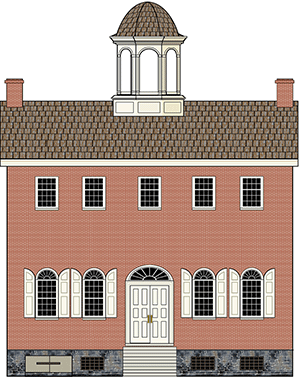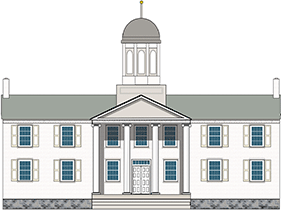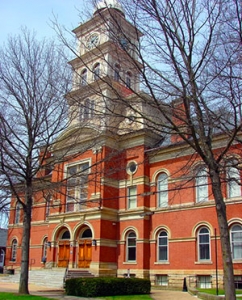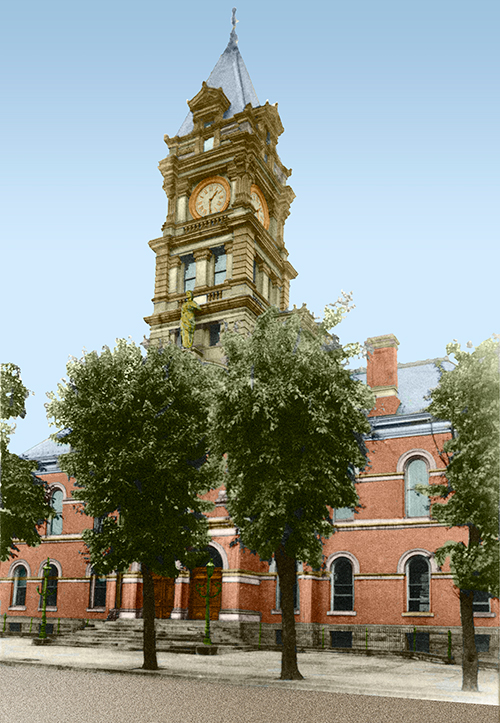Brief History of Huntingdon County’s Three Courthouses
By Nancy S. Shedd
Introduction
At the formation of Huntingdon County in 1787, when the town of Huntingdon was made the seat of justice, it was a village of perhaps two dozen log houses, with no public buildings except for a tavern or two. Thus Lodwick Sell’s tavern, facing on Allegheny Street at the rear of Swirles Himes’ present lot, was designated the site of county courts until a proper courthouse could be erected. County officials’ first attempt at constructing a combination courthouse and jail was doomed by a fire which leveled the building before its completion. And so courts apparently continued to be held in the tavern until completion in 1797 of a handsome brick courthouse in the middle of Third (then Smith) Street, facing on the south side of Penn (then Hill) Street.
 First Courthouse (1795 – 1842)
First Courthouse (1795 – 1842)
Complete records of construction of the 44 by 36 foot building by contractor John Blair show that excavation of the cellar commenced August 5, 1795, with William Rose and John Lindsay doing the digging and consuming nine quarts of whiskey during their eleven day’s labor. The impressive structure was built into the slope of Third Street, being two stories high on Penn and three stories high on the Allegheny Street face. It was topped by a well-proportioned cupola in which hung a 250 pound bell donated by town founder William Smith. Smith had first designated the bell as a gift to Huntingdon Borough, but the Trustees of Public Buildings for the County insisted he name the county as recipient if the bell was to hang in the county courthouse. This he did, and there the bell was used for fifty years to call together people of the community for courts, church services, and other public assemblies.
 Second Courthouse (1842 – 1882)
Second Courthouse (1842 – 1882)
By 1839, population of the county had so increased that more space was needed for conducting county business. The middle-of-the-street location of the first courthouse did not allow for expansion, and so four lots, comprising a plot 200 feet square, were secured on the site of the present courthouse. There, in 1841 and 42, the second Huntingdon County Courthouse – a T-shaped brick building with a two-story portico supported by four tall columns – was constructed with James and Robert Stitt as contractors. The new building was occupied in August of 1842, and the old courthouse was used as a public meeting hall until its demolition in 1848.
 Third Courthouse (1882 – Present)
Third Courthouse (1882 – Present)
A little less than forty years later, complaints were being heard about the inadequacy and inconvenience of the 1842 building. Proposals were received at first for additions and renovations to the existing building, but eventually the decision was made to remove the entire structure and build anew on the same site. M.E. Beebe, of Buffalo, New York, architect of the Cambria County Courthouse, was engaged by the Commissioners and presented plans for the third (and present) Huntingdon County Courthouse at April Court of 1882. Beebe’s plans were approved, and demolition of the 1842 building began a month later, on May 23rd. The Commissioners leased seven rooms in the Morrison House, an old stone building at the northeast corner of Third and Allegheny, as temporary quarters for the county offices. The Huntingdon Globe for June 8, 1882 reported that the airy, commodious rooms were a decided improvement on the damp, unhealthy condition of the old courthouse.
Architect Beebe described the new courthouse as French Renaissance style with arched window and door openings resting on sandstone string courses. The exterior facing was to be of Philadelphia pressed brick, finished at the top with a slated Mansard roof and galvanized iron cornice. Surmounting the tympanum arch over the main entrance was a zinc Statue of Justice above which rose an elaborate clock tower 140 feet high. Both the statue and the original tower were later removed. Justice’s place remains empty and her present whereabouts unknown; the tower was replaced in the 1930’s by the present tower.
The new courthouse was supplied with modern conveniences of the day–steam heat, in addition to slate-mantled fireplaces; gas lights throughout, magnified in the court room by two giant reflectors, one seven feet and the other five feet in diameter; and staff and public water closets, supplied with water from a tank on the third floor. Though not a fireproof building, care was taken to make the building safe by standards of the time: the staircases were iron, the corridor floors marble, and vaults were encased in boiler plate and concrete, and protected by iron shutters and doors.
The contract for erection of the building was awarded to Henry Snare & Co., a firm composed of Henry Snare, Nicholas Shaffer, Issac Lamp, and S.E. Henry, their bid being $71,300. Original specifications called for the interior to be finished in white oak, but the Commissioners changed their minds and ordered walnut instead. Furnishings costing $3,800 were purchased from F. Banshard & Bros., Erie, Pa, except for five dozen chairs made by Philip Brown of Huntingdon. Total cost, including extras added after the contract was drawn, was under $80,000. It was a good investment. With recent additions, renovations, and complete external refurbishing, the building still serves Huntingdon County as its seat of justice almost 120 years after its completion – a record in the history of Huntingdon County Courthouses.
Near Disaster Brings Improvements to Courthouse
At approximately 5:50 p.m. on April 24, 1992, fire struck the Huntingdon County Courthouse. Quick action by volunteer fire fighters saved the courthouse from total disaster. The fire gutted the planning office and left the basement offices of veteran’s affairs and human services with serious water damage. The second floor commissioners meeting room was damaged in extinguishing the fire, and the blaze left the entire courthouse with smoke damage.
Even though the building was closed for two weeks for a major cleanup, the primary elections were held the following Tuesday without any problems. The planning, veterans services, and human service offices were relocated to the Episcopal House just across the street, and county commissioners held meetings in their somewhat cramped office on the first floor.
It was necessary to gut the southeast wing to the bare brick walls prior to any reconstruction. Realizing that the tragedy presented an opportunity in disguise, the commissioners paid for additional improvements designed to bring the space up to modern requirements – insulation, relocation of partitions, and strengthening the floor of the second floor. Each level was rewired, dry walled, and painted. The former planning office on the first floor was converted into the commissioners’ meeting room. Dark blue carpet, vertical blinds, accenting burgundy furniture, and the original slate fireplace mantel combine to make this an attractive meeting room. Over the years this southeast wing of the courthouse has been used by various offices. Prior to being occupied by the planning office from 1971 to 1992, this area housed the county superintendent of schools. The temporary and more spacious planning office location in the Episcopal House across Penn Street was made permanent.
The basement level was restored to its previous status, housing the offices of veteran’s affairs and human services. On the second floor, the former commissioners meeting room was converted into an attractive jury room. Previous occupants of the basement area include the county weatherization office, children’s services, and even the county library, while the second floor was the location of the domestic relation’s office for many years.

Recent photograph of the courthouse.

Painted & restored photo of the courthouse from around 1900. ©2010 Fred R. Lang, used with permission.

Recent photograph of the courthouse.

Painted & restored photo of the courthouse from around 1900. ©2010 Fred R. Lang, used with permission.
Recent Courthouse Improvements
- In the 1960’s the second floor of the courthouse was totally remodeled. The main courtroom which originally occupied nearly the entire second floor was made narrower to make room for corridors down the east and west sides of the building. It was shortened to create the jury room and expanded law library on the south side of the building.
- In the early 1970’s the county made major improvements to the courthouse to correct safety deficiencies and to expand the space available. The county also constructed a new county prison adjacent to the original 1829 building and a county nursing home adjacent to J.C. Blair Memorial Hospital.
- A fireproof stair tower was constructed at the north end of the building to provide a safe exit in the event of fire. Exterior brick matches the original courthouse and the stairway runs from the basement to the attic.
- The west side of the courthouse received a three story addition which filled in a small court between the commissioner’s and prothonatory’s offices. This space was used to house the emergency management office (basement), expanded commissioner’s and tax assessment offices (first floor), and courtroom No. 2 and judges office (second floor).
- In the late 1980’s the county made the courthouse accessible to the handicapped through the addition of a modern hydraulic elevator. This was accompanied by remodeling several restrooms and restoration of areas affected by the construction of an elevator shaft through the building. In an effort to blend the new elevator with the historic nature of the building it was placed near the entrance to the register and recorder’s office in an opening formerly containing a stairway. In 1986 the Huntingdon County Courthouse and other historically significant buildings in downtown Huntingdon were made part of a recognized historic district by the U.S. Department of Interior.
- The 1990’s have brought continued change to the courthouse. A fire in April 1992 gutted the first floor office of the Huntingdon County Planning Commission, damaged basement offices and the second floor commissioner’s meeting room. The entire courthouse suffered smoke damage. Restoration work took over a year to complete. Further work is planned to insure the future of this National Historic Site. The entire courthouse roof was replaced in 1996 using a light-weight imitation slate product. In late 1999 the Board of Commissioners purchased a building at the corner of 5th and Penn Streets from Penn Central National Bank for use as a courthouse annex.
First, Second and Third courthouse illustrations, above, ©2010 Fred R. Lang – used with permission.
